A Lower False Positive Pulmonary Nodule Detection Approach for Early Lung Cancer Screening
Abstract
1. Introduction
- We propose an architecture called a multi-scale feature extractor (MSFE) to learn multi-scale feature representations of nodule candidates from training data. Based on MSFE, an anchor-box multi-scale feature detection network (MSFD-Net) is proposed to generate nodule candidates. It adapts well to detection difficulties caused by the heterogeneity of nodules through a multi-scale detection strategy.
- We build a candidate scoring network (CS-Net) to evaluate the confidence score of candidates. In our TSND, we use the CS-Net to estimate the score of candidates provided by an MSFD-Net to realize the false positive reduction.
- We develop an end-to-end nodule computer-aided detection (CAD) system to help with early nodule diagnosis. This integrates a preprocessing and TSND module. It can directly provide the detected nodule from raw LDCT scans.
2. Related Work
3. Materials and Methods
3.1. Materials
3.2. The Proposed Nodule Computer-Aided Detection System
| Algorithm 1 Pseudo code of the proposed nodule CAD system. |
|

3.2.1. Preprocessing

3.2.2. Two-Stage Nodule Detection
3.3. Nodule Candidate Detection
3.4. False Positive Reduction
3.5. Implementation Details
4. Results
4.1. Comparison Based on FROC
4.2. Comparison Based on FROC and Execution Time
4.3. The Effectiveness of CS-Net
4.4. Visualization
5. Discussion
5.1. Effect of Nodule Size on Detection
5.2. Statistical Significance Analysis of Differences in Detection Precision
5.3. Comparison with Other Detection Methods
6. Conclusions
Author Contributions
Funding
Institutional Review Board Statement
Informed Consent Statement
Data Availability Statement
Conflicts of Interest
References
- Sung, H.; Ferlay, J.; Siegel, R.L.; Laversanne, M.; Soerjomataram, I.; Jemal, A.; Bray, F. Global cancer statistics 2020: GLOBOCAN estimates of incidence and mortality worldwide for 36 cancers in 185 countries. CA A Cancer J. Clin. 2021, 71, 209–249. [Google Scholar] [CrossRef] [PubMed]
- Haasbeek, C.; Palma, D.; Visser, O.; Lagerwaard, F.; Slotman, B.; Senan, S. Early-stage lung cancer in elderly patients: A population-based study of changes in treatment patterns and survival in the Netherlands. Ann. Oncol. 2012, 23, 2743–2747. [Google Scholar] [CrossRef] [PubMed]
- Siegel, R.L.; Miller, K.D.; Jemal, A. Cancer statistics, 2015. CA A Cancer J. Clin. 2015, 65, 5–29. [Google Scholar] [CrossRef] [PubMed]
- Zeng, H.; Zheng, R.; Guo, Y.; Zhang, S.; Zou, X.; Wang, N.; Zhang, L.; Tang, J.; Chen, J.; Wei, K.; et al. Cancer survival in China, 2003–2005: A population-based study. Int. J. Cancer 2015, 136, 1921–1930. [Google Scholar] [CrossRef] [PubMed]
- Zhang, G.; Yang, Z.; Gong, L.; Jiang, S.; Wang, L.; Cao, X.; Wei, L.; Zhang, H.; Liu, Z. An appraisal of nodule diagnosis for lung cancer in CT images. J. Med. Syst. 2019, 43, 1–18. [Google Scholar] [CrossRef] [PubMed]
- Fahmy, D.; Kandil, H.; Khelifi, A.; Yaghi, M.; Ghazal, M.; Sharafeldeen, A.; Mahmoud, A.; El-Baz, A. How AI Can Help in the Diagnostic Dilemma of Pulmonary Nodules. Cancers 2022, 14, 1840. [Google Scholar] [CrossRef]
- Werncke, T.; Sonnow, L.; Meyer, B.C.; Lüpke, M.; Hinrichs, J.; Wacker, F.K.; von Falck, C. Ultra-high resolution C-Arm CT arthrography of the wrist: Radiation dose and image quality compared to conventional multidetector computed tomography. Eur. J. Radiol. 2017, 89, 191–199. [Google Scholar] [CrossRef]
- Xie, Y.; Xia, Y.; Zhang, J.; Song, Y.; Feng, D.; Fulham, M.; Cai, W. Knowledge-based collaborative deep learning for benign-malignant lung nodule classification on chest CT. IEEE Trans. Med. Imaging 2018, 38, 991–1004. [Google Scholar] [CrossRef]
- Han, Y.; Qi, H.; Wang, L.; Chen, C.; Miao, J.; Xu, H.; Wang, Z.; Guo, Z.; Xu, Q.; Lin, Q.; et al. Pulmonary nodules detection assistant platform: An effective computer aided system for early pulmonary nodules detection in physical examination. Comput. Methods Programs Biomed. 2022, 217, 106680. [Google Scholar] [CrossRef]
- Singh, S.; Gierada, D.S.; Pinsky, P.; Sanders, C.; Fineberg, N.; Sun, Y.; Lynch, D.; Nath, H. Reader variability in identifying pulmonary nodules on chest radiographs from the national lung screening trial. J. Thorac. Imaging 2012, 27, 249. [Google Scholar] [CrossRef]
- Litjens, G.; Kooi, T.; Bejnordi, B.E.; Setio, A.A.A.; Ciompi, F.; Ghafoorian, M.; Van Der Laak, J.A.; Van Ginneken, B.; Sánchez, C.I. A survey on deep learning in medical image analysis. Med. Image Anal. 2017, 42, 60–88. [Google Scholar] [CrossRef] [PubMed]
- Liao, F.; Liang, M.; Li, Z.; Hu, X.; Song, S. Evaluate the malignancy of pulmonary nodules using the 3-d deep leaky noisy-or network. IEEE Trans. Neural Netw. Learn. Syst. 2019, 30, 3484–3495. [Google Scholar] [CrossRef] [PubMed]
- Messay, T.; Hardie, R.C.; Rogers, S.K. A new computationally efficient CAD system for pulmonary nodule detection in CT imagery. Med. Image Anal. 2010, 14, 390–406. [Google Scholar] [CrossRef] [PubMed]
- Halder, A.; Chatterjee, S.; Dey, D.; Kole, S.; Munshi, S. An adaptive morphology based segmentation technique for lung nodule detection in thoracic CT image. Comput. Methods Programs Biomed. 2020, 197, 105720. [Google Scholar] [CrossRef] [PubMed]
- Jacobs, C.; Van Rikxoort, E.M.; Twellmann, T.; Scholten, E.T.; De Jong, P.A.; Kuhnigk, J.M.; Oudkerk, M.; De Koning, H.J.; Prokop, M.; Schaefer-Prokop, C.; et al. Automatic detection of subsolid pulmonary nodules in thoracic computed tomography images. Med. Image Anal. 2014, 18, 374–384. [Google Scholar] [CrossRef] [PubMed]
- Mei, J.; Cheng, M.M.; Xu, G.; Wan, L.R.; Zhang, H. SANet: A slice-aware network for pulmonary nodule detection. IEEE Trans. Pattern Anal. Mach. Intell. 2021. [Google Scholar] [CrossRef] [PubMed]
- Dou, Q.; Chen, H.; Jin, Y.; Lin, H.; Qin, J.; Heng, P.A. Automated pulmonary nodule detection via 3d convnets with online sample filtering and hybrid-loss residual learning. In Proceedings of the International conference on Medical Image Computing and Computer-Assisted Intervention, Quebec City, QC, Canada, 10–14 September 2017; pp. 630–638. [Google Scholar]
- Ding, J.; Li, A.; Hu, Z.; Wang, L. Accurate pulmonary nodule detection in computed tomography images using deep convolutional neural networks. In Proceedings of the International Conference on Medical Image Computing and Computer-Assisted Intervention, Quebec City, QC, Canada, 10–14 September 2017; pp. 559–567. [Google Scholar]
- Wang, B.; Qi, G.; Tang, S.; Zhang, L.; Deng, L.; Zhang, Y. Automated pulmonary nodule detection: High sensitivity with few candidates. In Proceedings of the International Conference on Medical Image Computing and Computer-Assisted Intervention, Granada, Spain, 16–20 September 2018; pp. 759–767. [Google Scholar]
- Zhu, W.; Liu, C.; Fan, W.; Xie, X. Deeplung: Deep 3d dual path nets for automated pulmonary nodule detection and classification. In Proceedings of the 2018 IEEE Winter Conference on Applications of Computer Vision (WACV), Lake Tahoe, NV, USA, 12–15 March 2018; pp. 673–681. [Google Scholar]
- Tang, H.; Zhang, C.; Xie, X. Nodulenet: Decoupled false positive reduction for pulmonary nodule detection and segmentation. In Proceedings of the International Conference on Medical Image Computing and Computer-Assisted Intervention, Shenzhen, China, 13–17 October 2019; pp. 266–274. [Google Scholar]
- Li, Y.; Fan, Y. DeepSEED: 3D squeeze-and-excitation encoder-decoder convolutional neural networks for pulmonary nodule detection. In Proceedings of the 2020 IEEE 17th International Symposium on Biomedical Imaging (ISBI), Lowa City, IA, USA, 3–7 April 2020; pp. 1866–1869. [Google Scholar]
- Luo, X.; Song, T.; Wang, G.; Chen, J.; Chen, Y.; Li, K.; Metaxas, D.N.; Zhang, S. SCPM-Net: An anchor-free 3D lung nodule detection network using sphere representation and center points matching. Med. Image Anal. 2022, 75, 102287. [Google Scholar] [CrossRef] [PubMed]
- Huang, Y.S.; Chou, P.R.; Chen, H.M.; Chang, Y.C.; Chang, R.F. One-stage pulmonary nodule detection using 3-D DCNN with feature fusion and attention mechanism in CT image. Comput. Methods Programs Biomed. 2022, 220, 106786. [Google Scholar] [CrossRef] [PubMed]
- Jacobs, C. LUng Nodule Analysis 2016. Website. 2016. Available online: https://luna16.grand-challenge.org/ (accessed on 24 March 2016).
- Setio, A.A.A.; Traverso, A.; De Bel, T.; Berens, M.S.; Van Den Bogaard, C.; Cerello, P.; Chen, H.; Dou, Q.; Fantacci, M.E.; Geurts, B.; et al. Validation, comparison, and combination of algorithms for automatic detection of pulmonary nodules in computed tomography images: The LUNA16 challenge. Med. Image Anal. 2017, 42, 1–13. [Google Scholar] [CrossRef]
- Song, T.; Chen, J.; Luo, X.; Huang, Y.; Liu, X.; Huang, N.; Chen, Y.; Ye, Z.; Sheng, H.; Zhang, S.; et al. CPM-Net: A 3D center-points matching network for pulmonary nodule detection in CT scans. In Proceedings of the International Conference on Medical Image Computing and Computer-Assisted Intervention, Lima, Peru, 4–8 October 2020; pp. 550–559. [Google Scholar]
- Ozdemir, O.; Russell, R.L.; Berlin, A.A. A 3D probabilistic deep learning system for detection and diagnosis of lung cancer using low-dose CT scans. IEEE Trans. Med. Imaging 2019, 39, 1419–1429. [Google Scholar] [CrossRef]
- Setio, A.A.A.; Ciompi, F.; Litjens, G.; Gerke, P.; Jacobs, C.; Van Riel, S.J.; Wille, M.M.W.; Naqibullah, M.; Sánchez, C.I.; Van Ginneken, B. Pulmonary nodule detection in CT images: False positive reduction using multi-view convolutional networks. IEEE Trans. Med. Imaging 2016, 35, 1160–1169. [Google Scholar] [PubMed]
- Kim, B.C.; Yoon, J.S.; Choi, J.S.; Suk, H.I. Multi-scale gradual integration CNN for false positive reduction in pulmonary nodule detection. Neural Netw. 2019, 115, 1–10. [Google Scholar] [PubMed]
- Mittapalli, P.S.; Thanikaiselvan, V. Multiscale CNN with compound fusions for false positive reduction in lung nodule detection. Artif. Intell. Med. 2021, 113, 102017. [Google Scholar] [CrossRef] [PubMed]
- Zhao, D.; Liu, Y.; Yin, H.; Wang, Z. A novel multi-scale CNNs for false positive reduction in pulmonary nodule detection. Expert Syst. Appl. 2022, 117652. [Google Scholar]
- Sun, L.; Wang, Z.; Pu, H.; Yuan, G.; Guo, L.; Pu, T.; Peng, Z. Attention-embedded complementary-stream CNN for false positive reduction in pulmonary nodule detection. Comput. Biol. Med. 2021, 133, 104357. [Google Scholar]
- Liu, W.; Anguelov, D.; Erhan, D.; Szegedy, C.; Reed, S.; Fu, C.Y.; Berg, A.C. Ssd: Single shot multibox detector. In Proceedings of the European Conference on Computer Vision, Amsterdam, The Netherlands, 11–14 October 2016; pp. 21–37. [Google Scholar]
- Lin, T.Y.; Dollár, P.; Girshick, R.; He, K.; Hariharan, B.; Belongie, S. Feature pyramid networks for object detection. In Proceedings of the IEEE conference on computer vision and pattern recognition, Honolulu, HI, USA, 21–26 July 2017; pp. 2117–2125. [Google Scholar]
- Ren, S.; He, K.; Girshick, R.; Sun, J. Faster r-cnn: Towards real-time object detection with region proposal networks. Adv. Neural Inf. Process. Syst. 2015, 28. [Google Scholar]
- Redmon, J.; Farhadi, A. YOLOv3: An Incremental Improvement. arXiv 2018, arXiv:1804.02767. [Google Scholar]
- Jiang, H.; Ma, H.; Qian, W.; Gao, M.; Li, Y. An automatic detection system of lung nodule based on multigroup patch-based deep learning network. IEEE J. Biomed. Health Inform. 2017, 22, 1227–1237. [Google Scholar]
- Hu, J.; Shen, L.; Sun, G. Squeeze-and-excitation networks. In Proceedings of the IEEE Conference on Computer Vision and Pattern Recognition, Salt Lake City, UT, USA, 18–22 June 2018; pp. 7132–7141. [Google Scholar]
- Ronneberger, O.; Fischer, P.; Brox, T. U-net: Convolutional networks for biomedical image segmentation. In Proceedings of the International Conference on Medical Image Computing and Computer-Assisted Intervention, Munich, Germany, 5–9 October 2015; pp. 234–241. [Google Scholar]
- Milletari, F.; Navab, N.; Ahmadi, S.A. V-net: Fully convolutional neural networks for volumetric medical image segmentation. In Proceedings of the 2016 fourth international conference on 3D vision (3DV), Stanford, CA, USA, 25–28 October 2016; pp. 565–571. [Google Scholar]
- van Rikxoort, E.M.; de Hoop, B.; Viergever, M.A.; Prokop, M.; van Ginneken, B. Automatic lung segmentation from thoracic computed tomography scans using a hybrid approach with error detection. Med. Phys. 2009, 36, 2934–2947. [Google Scholar] [CrossRef]
- Su, Y.; Li, D.; Chen, X. Lung nodule detection based on faster R-CNN framework. Comput. Methods Programs Biomed. 2021, 200, 105866. [Google Scholar] [CrossRef]
- Lin, T.Y.; Goyal, P.; Girshick, R.; He, K.; Dollár, P. Focal loss for dense object detection. In Proceedings of the IEEE International Conference on Computer Vision, Venice, Italy, 22–29 October 2017; pp. 2980–2988. [Google Scholar]
- Shrivastava, A.; Gupta, A.; Girshick, R. Training region-based object detectors with online hard example mining. In Proceedings of the IEEE Conference on Computer Vision and Pattern Recognition, Las Vegas, NV, USA, 27–30 June 2016; pp. 761–769. [Google Scholar]
- Lowekamp, B.C.; Chen, D.T.; Ibáñez, L.; Blezek, D. The design of SimpleITK. Front. Neuroinform. 2013, 7, 45. [Google Scholar] [CrossRef] [PubMed]
- Paszke, A.; Gross, S.; Massa, F.; Lerer, A.; Bradbury, J.; Chanan, G.; Killeen, T.; Lin, Z.; Gimelshein, N.; Antiga, L.; et al. Pytorch: An imperative style, high-performance deep learning library. Adv. Neural Inf. Process. Syst. 2019, 32. [Google Scholar]
- Xu, M.; Fralick, D.; Zheng, J.Z.; Wang, B.; Changyong, F. The differences and similarities between two-sample t-test and paired t-test. Shanghai Arch. Psychiatry 2017, 29, 184. [Google Scholar] [PubMed]
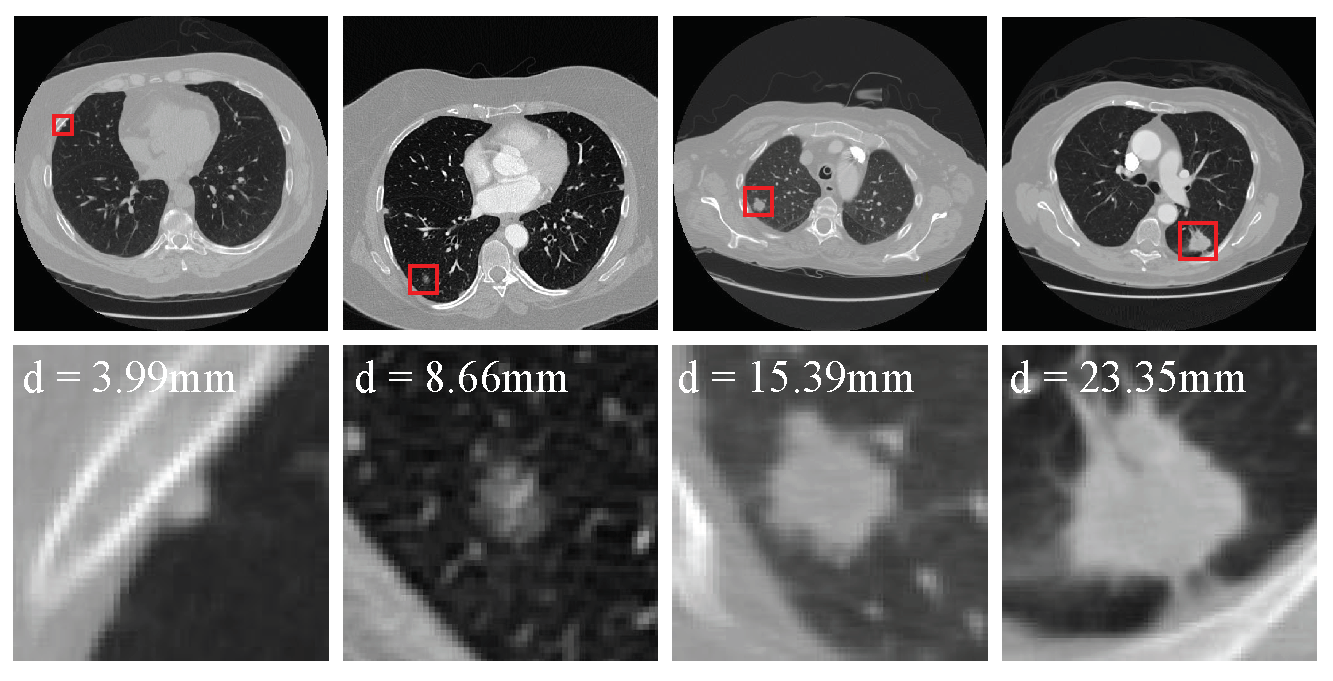
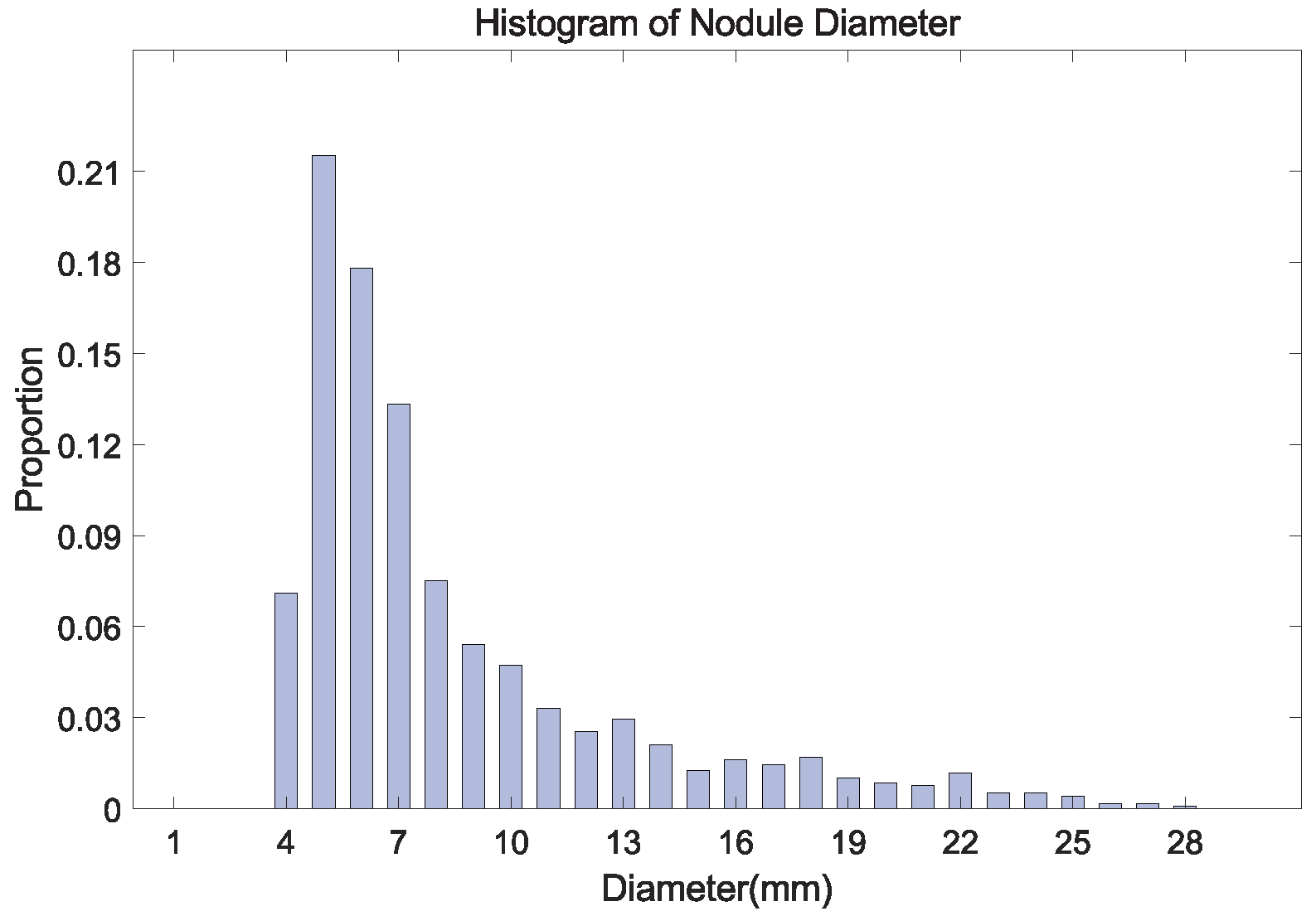
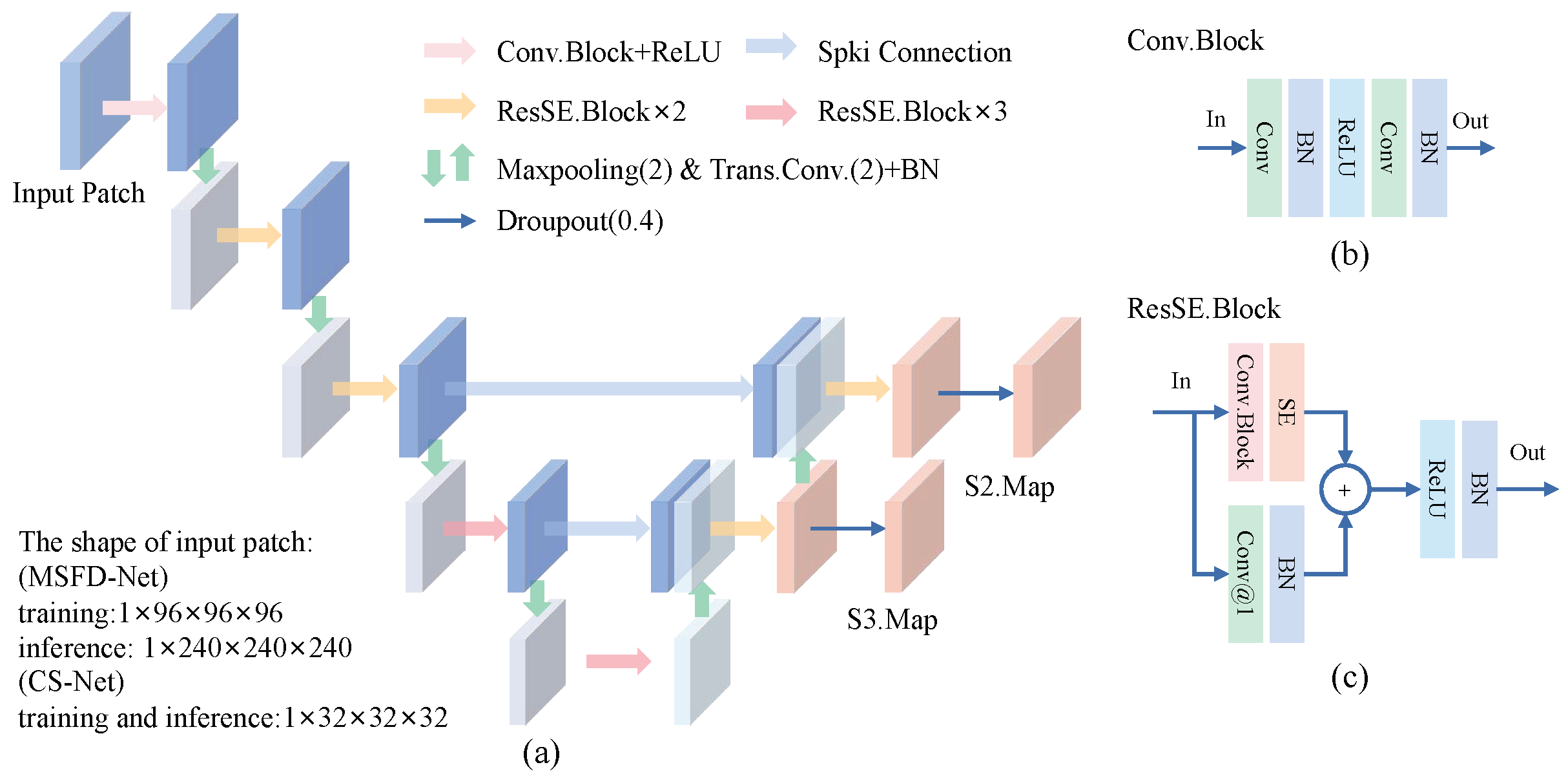

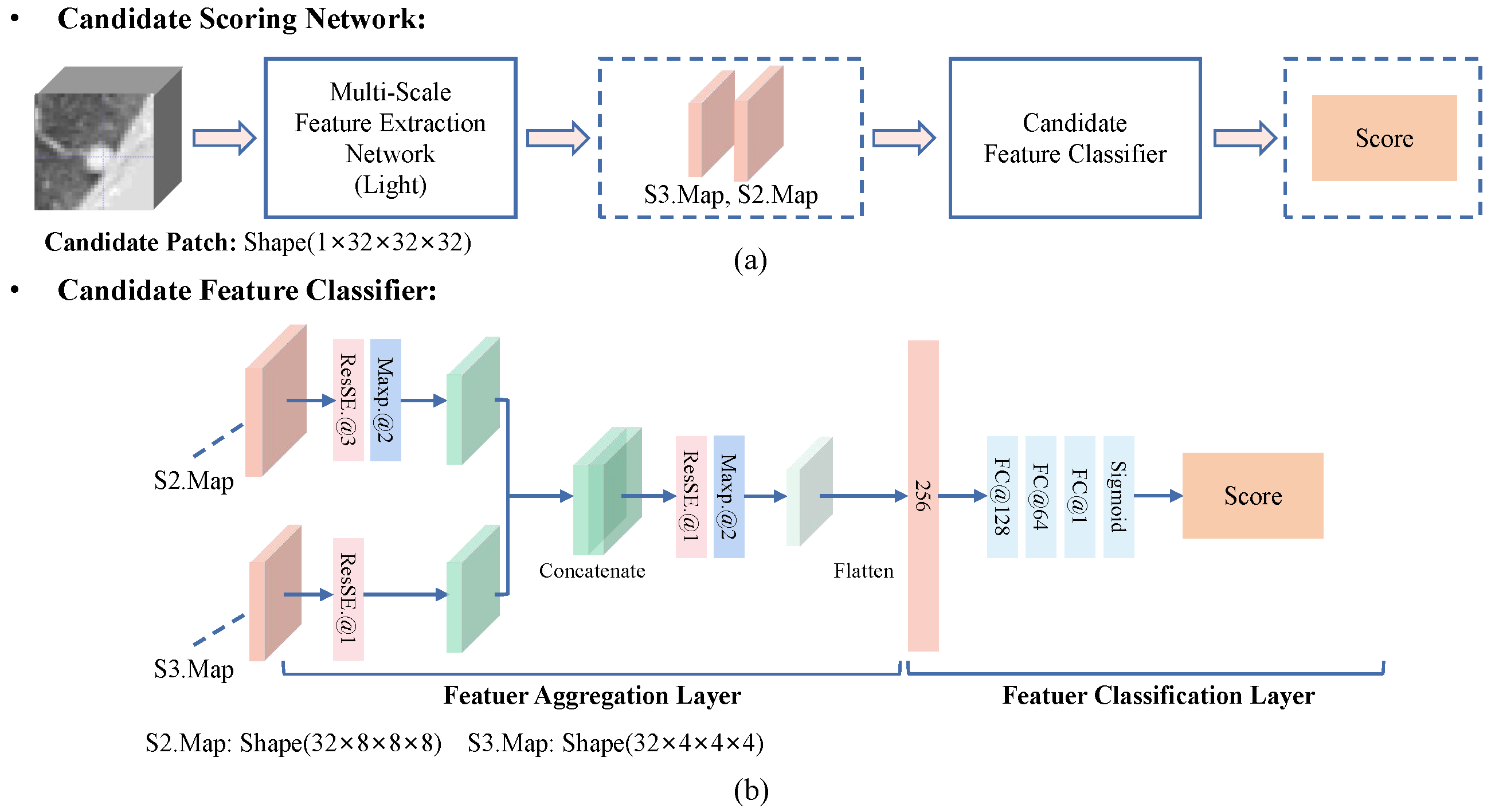


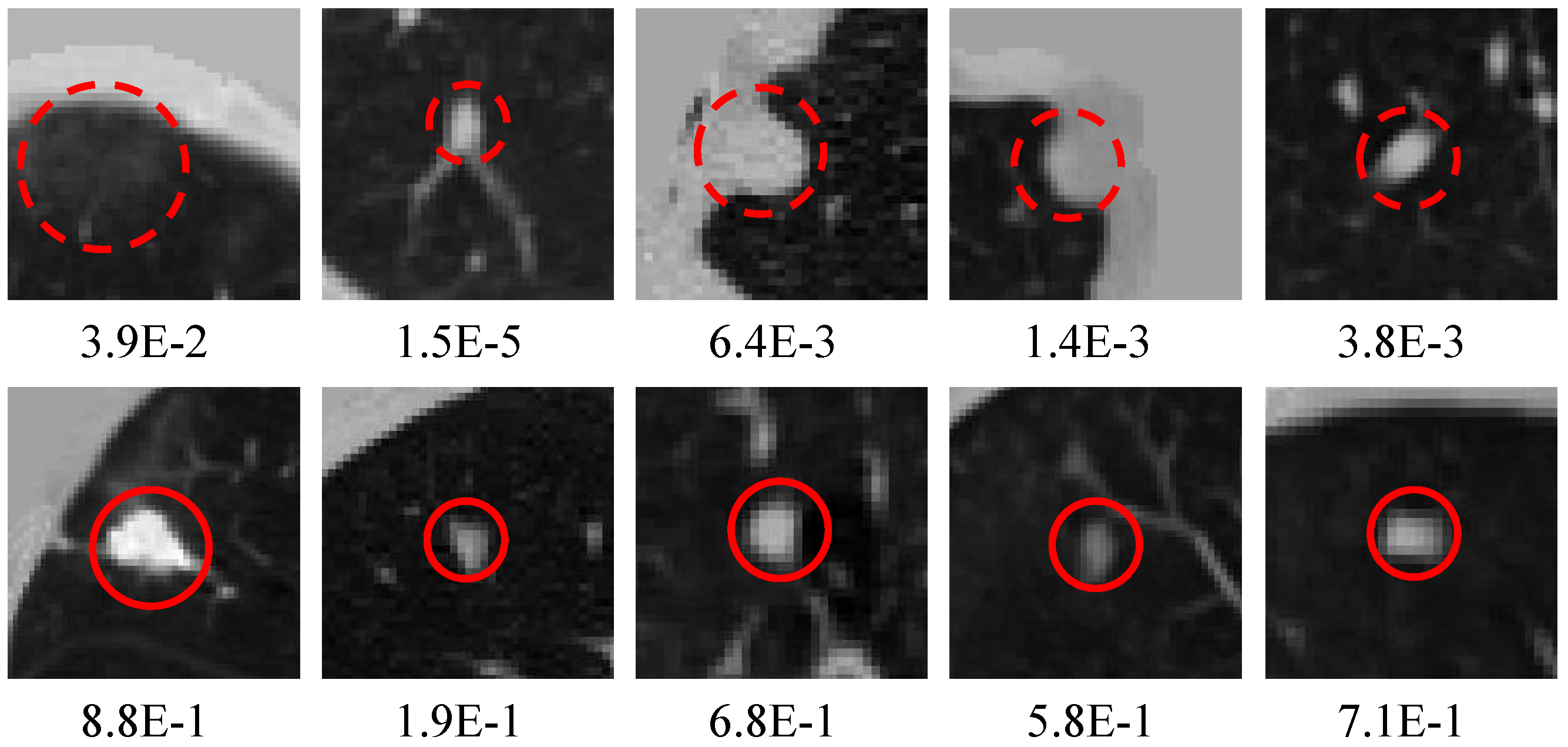

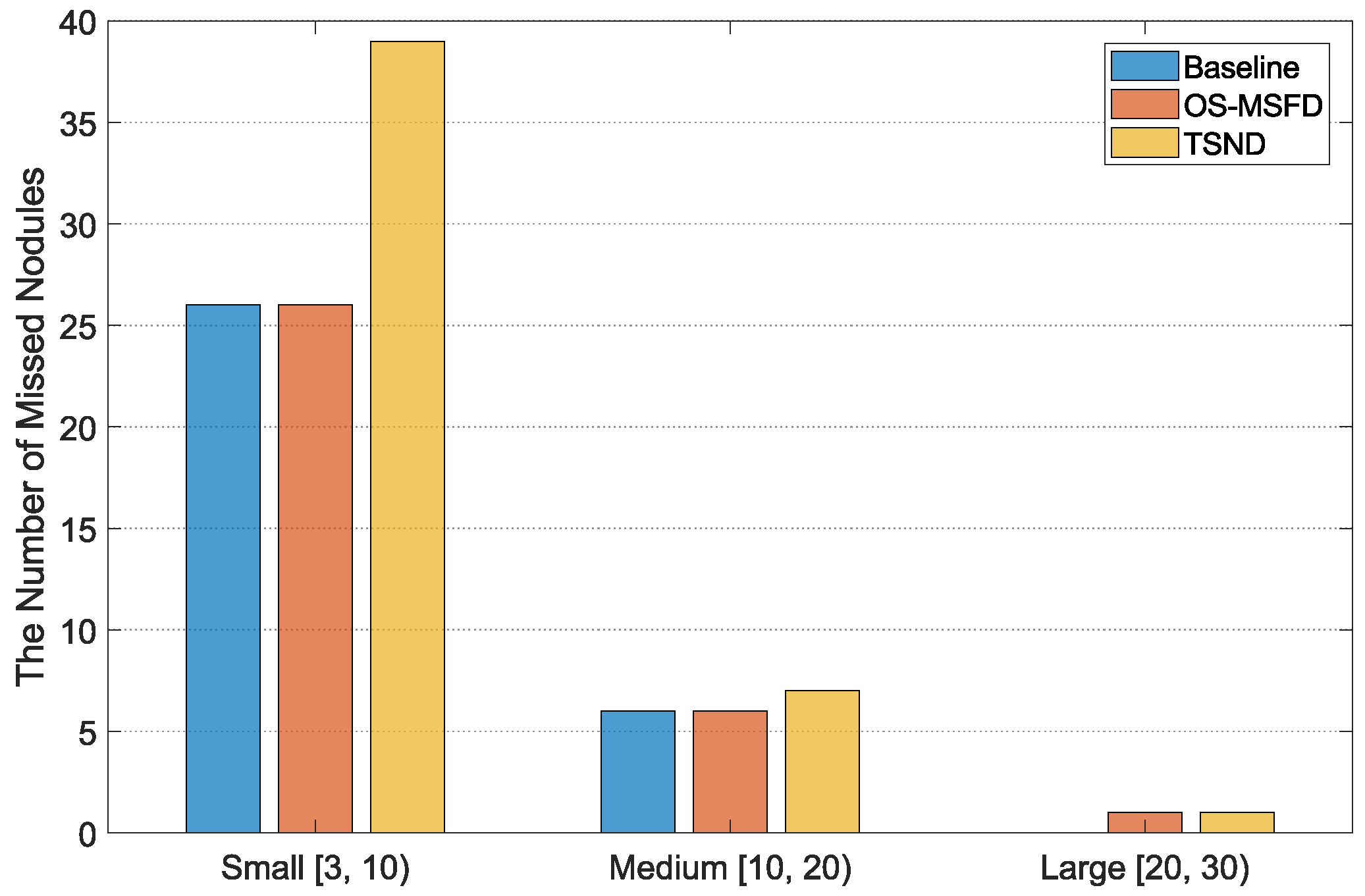
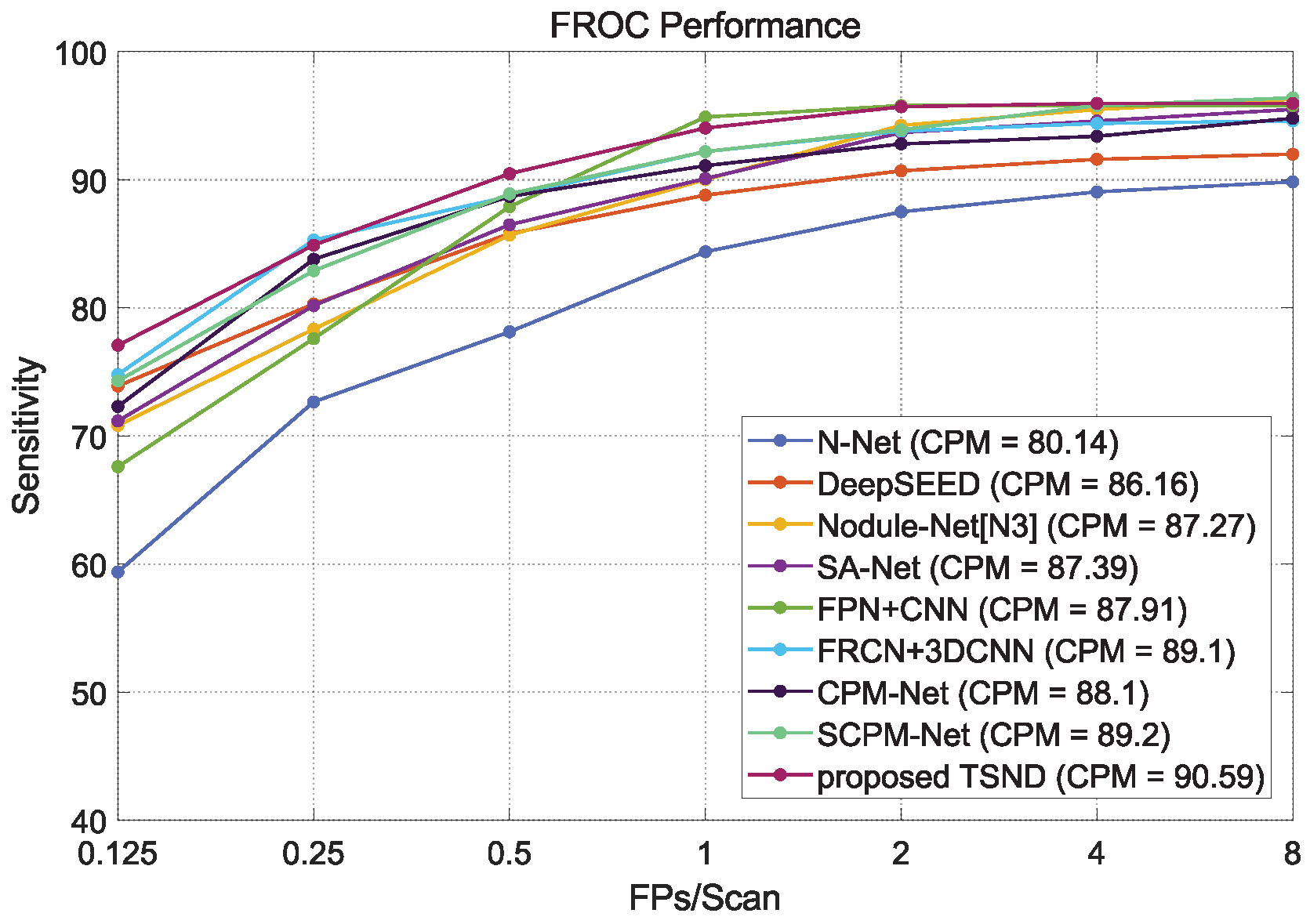
| Authors | Year | Dataset | Method | FPR |
|---|---|---|---|---|
| Han et al. [9] | 2022 | LUNA16 and LNPE1000 | UNet+RPN, U-shaped Net (UNet) [40] Region-based Proposal Network (RPN) [36] | w/o |
| Liao et al. [12] | 2019 | LUNA16 and DSB | N-Net, where the character N means the nodule | w/o |
| Zhu et al. [20] | 2018 | LUNA16 and LIDC-IDRI | DeepLung | w/o |
| Song et al. [27] | 2020 | LUNA16 | Center-points Matching Network (CPM-Net) | w/o |
| Luo et al. [23] | 2022 | LUNA16 | Sphere Center-points Matching Network (SCMP-Net) | w/o |
| Huang et al. [24] | 2022 | LUNA16 | You Only Look Once version 3 (YOLOv3) [37] | w/o |
| Li et al. [22] | 2020 | LUNA16 and LIDC-IDRI | Deep Squeeze-and-Excitation Encoder-Decoder (DeepSEED) | w/o |
| Dou et al. [17] | 2017 | LUNA16 | Convnets | w |
| Tang et al. [21] | 2019 | LUNA16 | Nodule-Net | w |
| Mei et al. [16] | 2021 | LUNA16 | Slice-Aware Network (SA-Net) | w |
| Ding et al. [18] | 2017 | LUNA16 | Faster Region-based CNN (FRCN) [36] | w |
| Ozdemir et al. [28] | 2019 | LUNA16 | V-Net+3DCNN, Volumetric Convolutional Network (V-Net) [41] | w |
| Wang et al. [19] | 2018 | LUNA16 | FPN+CNN, Feature Pyramid Network (FPN) [35] | w |
| Method | FROC | |||||||
|---|---|---|---|---|---|---|---|---|
| 0.125 | 0.25 | 0.5 | 1.0 | 2.0 | 4.0 | 8.0 | CPM | |
| Baseline | ||||||||
| OS-MSFD | ||||||||
| TSND | ||||||||
| Method | FPs/Scan | Sensitivity | Precision | ET/Scan |
|---|---|---|---|---|
| Baseline | ||||
| OS-MSFD | ||||
| TSND |
| Score | FROC | FPs/Scan | Candis/Scan | Sensitivity | |||
|---|---|---|---|---|---|---|---|
| CPM | |||||||
| Method | Sensitivity | Precision | |||||
|---|---|---|---|---|---|---|---|
| Small | Medium | Large | Small | Medium | Large | ||
| Baseline | |||||||
| OS-MSFD | |||||||
| TSND | |||||||
| Method | FROC | FPR | Strategy | |||||||
|---|---|---|---|---|---|---|---|---|---|---|
| 0.125 | 0.25 | 0.5 | 1.0 | 2.0 | 4.0 | 8.0 | CPM | |||
| N-Net [12] | w/o | Anchor-Box | ||||||||
| DeepSEED [22] | w/o | Anchor-Box | ||||||||
| Nodule-Net[N3] [21] | w | Anchor-Box | ||||||||
| SA-Net [16] | w | Anchor-Box | ||||||||
| FPN+CNN [19] | w | Anchor-Box | ||||||||
| CPM-Net [27] | w/o | Anchor-Free | ||||||||
| FRCN+3DCNN [18] | w | Anchor-Box | ||||||||
| SCPM-Net [23] | w/o | Anchor-Free | ||||||||
| proposed TSND | w | Anchor-Box | ||||||||
Publisher’s Note: MDPI stays neutral with regard to jurisdictional claims in published maps and institutional affiliations. |
© 2022 by the authors. Licensee MDPI, Basel, Switzerland. This article is an open access article distributed under the terms and conditions of the Creative Commons Attribution (CC BY) license (https://creativecommons.org/licenses/by/4.0/).
Share and Cite
Zheng, S.; Kong, S.; Huang, Z.; Pan, L.; Zeng, T.; Zheng, B.; Yang, M.; Liu, Z. A Lower False Positive Pulmonary Nodule Detection Approach for Early Lung Cancer Screening. Diagnostics 2022, 12, 2660. https://doi.org/10.3390/diagnostics12112660
Zheng S, Kong S, Huang Z, Pan L, Zeng T, Zheng B, Yang M, Liu Z. A Lower False Positive Pulmonary Nodule Detection Approach for Early Lung Cancer Screening. Diagnostics. 2022; 12(11):2660. https://doi.org/10.3390/diagnostics12112660
Chicago/Turabian StyleZheng, Shaohua, Shaohua Kong, Zihan Huang, Lin Pan, Taidui Zeng, Bin Zheng, Mingjing Yang, and Zheng Liu. 2022. "A Lower False Positive Pulmonary Nodule Detection Approach for Early Lung Cancer Screening" Diagnostics 12, no. 11: 2660. https://doi.org/10.3390/diagnostics12112660
APA StyleZheng, S., Kong, S., Huang, Z., Pan, L., Zeng, T., Zheng, B., Yang, M., & Liu, Z. (2022). A Lower False Positive Pulmonary Nodule Detection Approach for Early Lung Cancer Screening. Diagnostics, 12(11), 2660. https://doi.org/10.3390/diagnostics12112660







